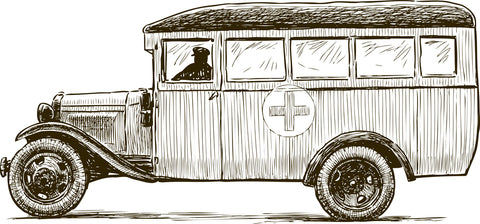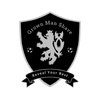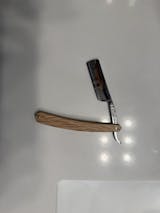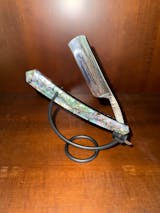The pre-shaving ritual is the fundamental foundation to a closer shave and the most comfortable shave possible. Shaving is a ceremony, a time for introspection, a moment to strategize the conquests of the day, and one of the most relaxing and important steps to traditional grooming you should not miss.
Most men will go through a lifetime with the same shaving routine without ever getting that oh-so-wonderful barbershop shave that has helped guys hone their dapper looks for decades because using a cartridge razor just won't cut it. Properly prepping your beard and adding a skincare regimen, without a doubt, is something you must do every day before you put any tool in your hand and start shaving.
Any experienced traditional wet shaver will tell you that getting a closer shave with any tool, whether it's a straight razor or safety razor, is part art and part science. Even the best shaving products won't make up for a mediocre pre-shave routine. Yes, it is more delicate and slower than dry shaving. However, taking a few moments for proper preparation is an essential part of the process of a professional shave, especially if a comfortable flawless shave is your goal!
The purpose of a pre-shave ritual is ultimately to build a solid foundation for a great shave and prep skin and soften facial hair and protect your skin from the beatings from prolonged water exposure and the micro abrasions from a blade’s cutthroat edge.
Your Pre-Shave Ritual Checklist:
- A hot towel or a warm towel for those with sensitive skin
- High-quality pre-shave oil, pre-shave balm, or gel
- A mild facial cleansing product
- Essential but optional is a beard shampoo to condition hair and the skin
- A manly yet luxurious soap, shaving cream is also great
- Your preferred shaving brush
- A shaving bowl or scuttle
- Aftershave balm, post shave balm, or shave tonic for a cooling burst
- Moisturizer

Pre-Shave Routine 101 what you will learn:
-
How to prepare your skin for wet shaving
-
How to choose a shaving brush that is right for you
-
Proper lathering techniques
-
How to manage skin irritation, ingrown hairs, and relieve and avoid razor burn
-
Dealing with thick or coarse facial hair
-
Learning how to shave in the direction the hair grows
-
Learning how to prevent and treat nicks, cuts, and extreme irritation
-
Prepping your shaving equipment and keep your razors sharp
Pre-Shave Shaving Ritual Skincare Regimen

Your post shaving technique results heavily rely on your pre-shave ritual, which creates an additional layer that protects your skin from dehydration, overexposure to moisture, razor burn, and the edge of your razor of choice.
Here is how you should prepare your skin for wet shaving:
- Wash and cleanse your face with water and your trusted facial wash.
- Warm your face and beard by running hot water through a towel and then over the surface you want to shave for at least 30 seconds.
- Apply a few drops of pre-shave oil to your palm and massage it on the area you want to shave (if you’re shaving unmentionable sensitive areas, avoid pre-shave oils with eucalyptus oil or menthol, you’re welcome)
- Prepare your shaving soap or shaving cream or lather while waiting for your skin or beard to soak in the pre-shave oil.
- Use your shaving brush to apply the lather on the face using a circular motion to gently exfoliate the surface and lift the hair from the skin.
Pre-Shave Facial Cleansing And Exfoliation
Shaving inflicts micro abrasions or microscopic cuts on the skin’s surface. Cleansing and exfoliation help sterilize your skin. Most post-shave irritations, like razor bumps, happen when dirt and bacteria enter these open cuts.
Exfoliation is the process of removing dead skin cells and helps lift facial follicles, an essential step to getting a baby-butt smooth shave. Every day, we have 30,000 to 40,000 dead skin cells, which can accumulate on the skin and could clog up your razor and rob you of a great shave.
An ounce of prevention goes a long way. Clean your face before shaving with a mild cleanser which helps with exfoliation. Mild is the key term here because harsh soaps can strip away the natural oils of your face. Wash gently with warm water to soften dead skin cells, gently massaging a hot towel on your face or using a gentle circular motion while creating lather and rinse with cold water well. After, pat dry with your favorite shaving towels.
Remember, stay away from chemical exfoliators as this might irritate your skin further.

Hot Towel Prep To Soften Facial hair
You may have heard how hot water opens the pores through several skincare gurus. However, this is a myth. Pores are nothing but tiny openings on the skin that cannot open or close because they are not muscles.
Applying a hot towel to the skin for at least 30 seconds does not open the pores. Instead, it clears the pores of dirt, dead skin cells, and sebum debris clogging its opening. As a result, the pores look more pronounced.
Using a pre-shave oil will condition hair and soften facial hair making it easier for the razor to lift and glide and cut facial hair close to the skin level.

Pre-Shave Oil & Application
Pre-shave oil, commonly known as a shaving oil, often contains natural ingredients such as Aloe Vera and Vitamin E that help to prevent inflammation, helping reduce razor burn.
Pre-shave oil, gels, and lotions are excellent for keeping your skin hydrated during prolonged water exposure because oils are hydrophobic and create a barrier between shaving lather and your skin.
Many wet shavers skip this step and deem it unnecessary. The Art Of Shaving states that this is an initial step, a trademark of its “four elements of the ideal shave.” However, if you are a newbie shaver, it is advisable to add this to your pre-shave ritual and see how it benefits your skin personally. Later on, you can decide whether it's right for your skin type or not.
Look for shaving products with a blend of highly-moisturizing carrier oils such as Olive oil, Castor oil, Jojoba, Hemp, and Coconut with nourishing essential oils for the ultimate skin benefits. Got sensitive skin? Look for a sensitive skin formula with calming green tea and oat extract, and you will get the best old-world quality with modern style.
Note that a little goes a long way with oils. Pre-shave oils are thicker and more viscous in consistency and should be used sparsely.
Put a few drops on your palm and rub them together before massaging them onto the skin and beard.

How To Choose A Shaving Brush
Shaving brushes have a long history and tradition. Shaving brush knots come from either badger, boar, horse, or synthetic hair. Among all these, which is the best?
Shaving brushes are not as complicated as double-edge safety or straight-edge razors. However, there are some things to take into consideration, such as shaving routine and skin type.
The knot size or knot diameter indicates the amount of hair that has been packed into the handle. A larger knot retains more water and feels firmer against the skin. The length from the tip of the brush determines loft and a larger loft retains more water, making it easier to lather up larger areas. A shaving brush with a longer loft also has more flex in the bristles, which is softer against the skin. A shorter loft will provide more stability to the bristles and a stiffer feeling brush. Each has its own softness and water retention properties.
If you have sensitive skin, avoid a shaving brush with natural bristles. This kind of shaving brush may irritate your skin more since they are often bleached or treated with chemicals that may have an unpleasant smell.
The most important way to choose a shaving brush is as unique as you are. Choose one that feels comfortable on your skin, something in between too soft and flexible and too coarse and stiff. The best way to tell if a shaving brush is right for you is to review its performance one month after it has been broken in.
If you are a beginner, you can try using synthetic brushes since they are easy to find and more affordable compared to premium luxury shaving brushes.

Lathering Shave Soap Or Shaving cream
A luxurious soap or high-quality shaving cream works best when it's whipped into a thick, generous lather. Always purchase a high-quality soap because they are formulated to expel dirt and grime without stripping your skin of its natural oils. Avoid those canned creams. They may be convenient but are not the best for your skin or the environment. If space saving is a concern or you often travel, most of your favorite brands offer different sizes and travel-friendly options.
To lather shaving soap, you will need three things: a puck of shave soap, a shaving brush, and a shaving scuttle or bowl.
Here is a simplified guide on how to lather shave soap:
- Add a few drops of water to the soap’s top surface.
- Swirl the brush on top to get some of the soap.
- Put a small amount of warm water in the lower chamber of your scuttle or bowl. You can add more as needed.
- Whip until you get your preferred consistency. A good tip is if your brush and lather create a suction when you lift it from your face, the lather is a perfect consistency.
- Keep a water-filled spray bottle handy if you need to lightly rehydrate your lather.
If you're on the fence between shaving soap or shaving cream, the never-ending question which is best, you can read more in-depth on the subject in our post shaving soap vs. shaving cream.
Applying The Lather
The best way to apply the lather on the face for wet shaving is to scoop it from the scuttle or bowl and swirl it in the skin using a circular motion. The bristles of the shaving brush will gently exfoliate the skin and lift the hair from the surface and prepare your facial hair for shaving. In the end, you should have an evenly applied lather to help your razor glide smoothly.
Once the lather is on your face, you can refer to your printed face mapping guide. Draw the guiding lines on the lather using your finger to help determine which shaving direction you should use for a more efficient shaving process. Make sure to clean and dry your brush properly to avoid it from getting disintigrated.
Prepping Your Shaving Tool
The razor you choose is the paintbrush that will define how well you will look good after shaving and the key to the best shave you can get. So much goes into prepping the skin to get the best shave of your life, but it will all lead to disappointing results and you'll have to deal with constant razor burn. Never use a dull blade. If you do not know how to prep your shaving tool or how to keep your razor blade sharp, read our guide.
For those who are using a straight razor, honing and stropping your straight edge blade onto an abrasive leather is a must for prepping your shaving tool. Stropping realigns any burrs or microscopic chips that get in the way of getting a smooth shave and cause irritation, nicks, and cuts.
If you have ditched those environmentally unfriendly cartridge razors and using a classic double-edge safety razor to prep your wet shave tool, never use a dull blade. You should replace your safety razor blades every 3 to 5 shaves and keep your razor sterile and away from constant moisture. The key here is to always start with light pressure—too much pressure is where things go wrong and fast.
Shower Then Shave Or Shave Then Shower?

Hot water—or long showers at any temperature—removes essential oils from your skin, making your shave less comfortable. That said, you still want to use soap on your face, but in this case, a mild cleanser is best because it doesn't strip away too much oil
If you love having a clean-shaven face at all times, you surely know the inconvenience of shaving every day. Your best solution is to find a shortcut to getting a quick shave. With that, should you shave before showering or shave then shower? Or would you rather… shave in the shower?
Shaving before taking a shower is like washing your face then taking a shower. It is repetitive and unnecessary—especially if you are wet shaving. However, if you are using clippers, it is okay to dry shave before taking a shower, as the latter helps clean off any fallen hair.
Meanwhile, it would be best to shower before shaving for wet shavers. Considering the pre-shave ritual mentioned before, a hot shower softens the hair and clears the pores for a smoother and more hygienic shaving experience.
Wet Shaving Triage

How To Manage Ingrown Hair & Razor Burn
There is no shame in skin irritation and getting ingrown hairs and razor burn as a beginner. Even expert shavers still sometimes have to deal with it too. Nonetheless, do not stick to your routine if it keeps giving you problems. Here’s how to avoid and manage ingrown hair and razor burn:
- Pre-shave prep - Do hot towel steam, exfoliate, and apply a natural pre-shave oil.
- During your shave - Follow the grain on your first pass and let the razor's weight do the work. This reduces razor burn and ingrown hairs.
- Post shave - Always wash off excess lather and hair debris, and apply an aftershave product.
- Calm inflammation - Apply a potassium alum block, which is a natural antiseptic and astringent. An alum block is a wet shaver's best friend for a cooling burst of relief after a shave and reducing inflammation.
How To Deal With Nicks And Cuts
Sometimes, nicks and cuts are inevitable despite the amount of care and effort you put into your shaving routine. The best way to deal with nicks and cuts is to treat them as soon as possible with the following remedies:
- Firm pressure - Press your clean finger over the cut and apply firm pressure.
- Cold compress - Hold an ice cube or a cold compress above the area and press firmly.
- Witch hazel - Use it as a toner on the bleeding area only for minor nicks and cuts; it is also another natural option vs. alcohol.
- Aftershave balm - Seal the open shaving cut with a natural unscented alcohol-free balm.
- Styptic pencil or alum blocks - Styptic pencils stop bleeding by coagulating blood on the surface of a wound, just like a scab. Alum blocks use the same materials for first aid and can also be found in pencil formats. Styptic pencils are formulated with aluminum salts like aluminum sulfate, potassium aluminum sulfate, or sodium aluminum sulfate, whereas an alum block is purely made from potassium alum, a naturally occurring mineral and composite known for its antiseptic and astringent properties.
If the bleeding does not subside despite the first-aid treatments for shaving nicks and cuts above, consult with a doctor.
The Key Takeaways
A real grown man's shave could never be without a proper pre-shave ritual. At Grown Man Shave, our ethos is to elevate men's modern style, break down each element of a shave, and compile decades worth of experience to guide you through your journey from the beginner to aficionado in our Traditional Wet Shaving Guides. A professional shave at home is easy to achieve, and the pre-shave ritual is vital for that baby-butt smooth shave. Indulge in the true benefits that wet shaving has to offer!

















